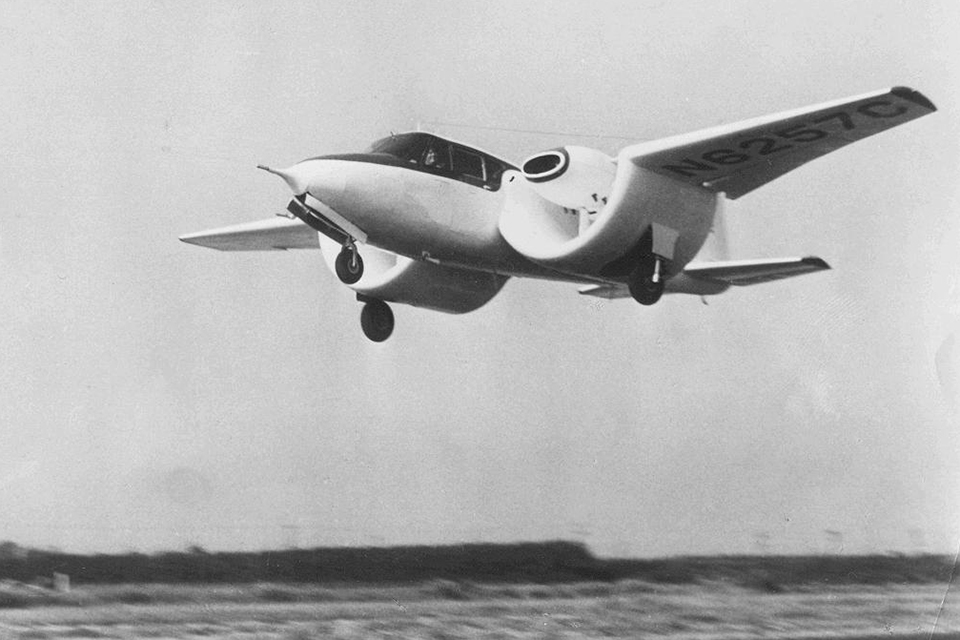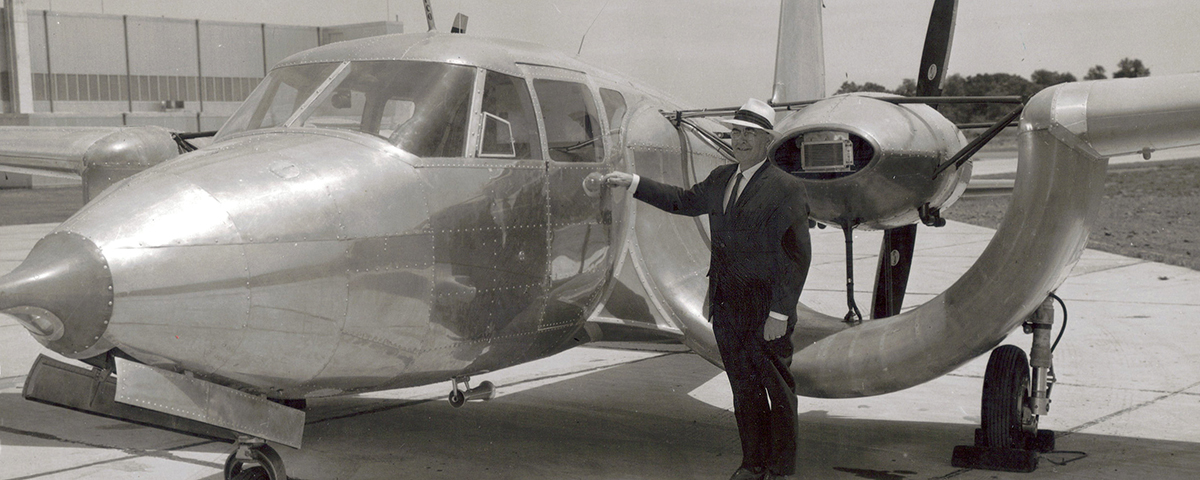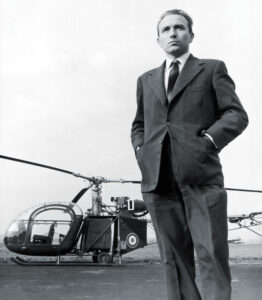Like many unique design concepts, the channel wing was the product of one man’s vision and persistence. Willard Custer, a great-grand nephew of George Armstrong Custer, has been called the father of short takeoff and landing aircraft. That may be a slight exaggeration given that there were several other STOL aircraft under development in the late 1930s, including Germany’s Fieseler Fi-156 Storch, Britain’s Westland Lysander and the U.S. Army’s Ryan YO-51 Dragonfly. Yet there is little doubt that Custer was among the earliest pioneers in the field, and that his solution to the problem was completely original.
It all began in the late 1920s, when Custer witnessed a barn roof lifting off in a windstorm. Since the roof hadn’t been moving forward when it rose, it occurred to Custer that it wasn’t the speed of an airfoil through the air that created lift, but rather the speed of the air over the airfoil. He reasoned that if the air’s speed over a stationary airfoil could be artificially augmented, then the airfoil’s efficiency could be greatly increased. Custer called the principle “aerophysics.” After years of building and testing a variety of models, he hit upon a unique airfoil in the form of a semicircular duct with a pusher propeller mounted in close proximity to the trailing edge. In essence, his channel wing arrangement was like the bottom half of a ducted propeller or venturi tube.
After spending years experimenting on a variety of models, Custer finally built a full-size flying prototype, which he called the CCW-1. Powered by two 75-hp engines driving 6-foot-diameter pusher propellers, the CCW-1 flew for the first time on November 12, 1942. Custer calculated that the channels generated 13.8 pounds of lift per horsepower, which he estimated to be as much as 3 1⁄2 times the amount that a conventional set of straight wings would have produced. The result was that the CCW-1 possessed outstanding short-takeoff and slow-flying performance. Although the CCW-1 could not actually hover, it did demonstrate the ability to take off vertically in a light breeze. The aircraft was originally flown with conventional wing surfaces outboard of the channels, but as testing went on the wings were progressively cropped to prove that it could fly perfectly well without them. The CCW-1 was successfully test-flown for more than 300 hours.
In 1943 Custer demonstrated the CCW-1 in Beltsville, Md., to U.S. Army Brig. Gen. W.E. Gilmore, who recommended that the Army Air Forces institute a test program. During the next few years, the Army conducted a series of tests on both the aircraft itself and on wind tunnel models. In 1947, however, the newly reorganized U.S. Air Force discontinued its investigation into the channel wing concept. Custer blamed interference from helicopter developers, but a more likely explanation is that in the austere immediate postwar period the Air Force simply lacked the funds for research into unconventional STOL aircraft.
Undeterred, Custer continued experimenting on his own and promoting his wing design. In 1947 he managed to get the CCW-1 featured on the cover of Popular Mechanics. Although Custer failed to attract support from the mainstream aviation industry, he did acquire sufficient financial backing to build a series of increasingly ambitious prototypes. In 1948, for example, he contracted with Taylorcraft to build the CCW-2, a new experimental channel wing prototype based on the fuselage of a Taylor Cub lightplane.
The ultimate development of Custer’s channel wing principle was the CCW-5, a modern-looking twin-engine plane with a five-seat enclosed cabin. Using the fuselage and tail surfaces of the uncompleted third production Baumann B-250 Brigadier, a twin-engine cabin monoplane, Custer produced his CCW-5 by replacing the Baumann’s conventional wings with a set of his own channel wing surfaces. The conversion was facilitated by the fact that the B-250 had originally been designed with midmounted wings and pusher propellers. Powered by a pair of 260-hp Continental engines arranged as pushers, the CCW-5 had a wingspan of 41 feet 2 inches and a length of 28 feet 81⁄2 inches. It weighed 3,674 pounds empty and had a normal loaded weight of 4,925 pounds.

First flown in July 1953, the CCW-5 proved successful aerodynamically, if not commercially. Although the structural complexity of the channel wings made the CCW-5 heavier than the original Baumann, it could take off in three seconds after a 100-foot roll and fly controllably at speeds between 22 and 200 mph. In addition, it could make steeply banked turns at speeds so low that any other airplane would stall and crash. When the channel wings did stall, their stalling characteristics were described as gentle and viceless. The CCW-5’s performance was considered all the more remarkable because, in contrast to other STOL aircraft, the Custer’s wings possessed no flaps, slots or other airfoil-modifying devices.
Throughout the 1950s Custer tried unsuccessfully to sell his idea to a variety of aircraft manufacturers. Some insight into the reason for his lack of success may be gleaned from Pete D’Anna, a former executive with Goodyear Aircraft Corporation, who in an interview recounted a series of meetings he conducted with Custer in 1956 with a view to acquiring his channel wing technology for Goodyear. D’Anna described Custer as “a smooth talking salesman with a good grasp of aeronautics, but a lousy habit of not providing data beyond small reports, photos and brochures he used while trying to sell the designs.”
Undeterred, in 1964 Custer finally managed to attract sufficient financial backing to establish his own company for the manufacture of channel wing aircraft. The firm soon folded, however, after completing just one production CCW-5. It has been intimated that Custer’s firm fell victim to an investigation by the Securities and Exchange Commission similar to one that destroyed Preston Tucker’s controversial automobile company in the late 1940s.
Despite the demonstrated efficiency of the CCW-5’s design and decades of promotional effort on the part of Willard Custer and his son, Harold, the channel wing idea never managed to gain acceptance from the mainstream aviation industry. Some have speculated that its failure was due as much to the inventor’s personality as to any inefficiency in the design itself. Perhaps Custer would have been taken more seriously if he had been a member of the design staff of one of the major aircraft corporations such as Douglas, Boeing or the famous Lockheed Skunk Works. He was always a rank outsider in the aviation design community, an empirical inventor with a penchant for what nowadays is called “thinking outside the box.” As a result, he has generally been dismissed by most of the aviation establishment as something of a crackpot.
Although Willard Custer died in 1985, the channel wing story did not end with him. Members of the mainstream aviation community have recently begun to reinvestigate the wing’s possibilities. In 2000 Dennis M. Bushnell of the Langley Research Center at Hampton, Va., published a study on advanced aeronautical configurations in which he commented favorably on the potential of an enhanced version of Custer’s channel wing in future STOL aircraft. In 2002 Robert J. Englar of Georgia Tech and Bryan A. Campbell of NASA conducted a detailed wind tunnel study of a channel wing incorporating advanced pneumatic circulation control airfoil and slot technology that was not available in Custer’s day. The results of their experiments revealed a reduction in drag over the original channel wing, as well as enhanced engine-out controllability and an increase of the lift coefficient to 8.5.
Some aviation experts have proposed that the substitution of an enhanced channel wing for the complex tilt-rotor arrangement featured in the U.S. Marine Corp’s Bell V-22 Osprey assault transport would result in an aircraft that could outperform the current version in every respect save for the ability to hover, and would be far less expensive to purchase and operate. It might take some time, but there may yet be a future for Willard Custer’s remarkable invention.
Two of Custer’s channel wing aircraft survive. The original CCW-1 resides at the National Air and Space Museum’s Paul Garber Facility in Suitland, Md., and the sole “production” CCW-5 is currently undergoing restoration at the Mid-Atlantic Air Museum in Reading, Pa.
Originally published in the July 2009 issue of Aviation History. To subscribe, click here.






